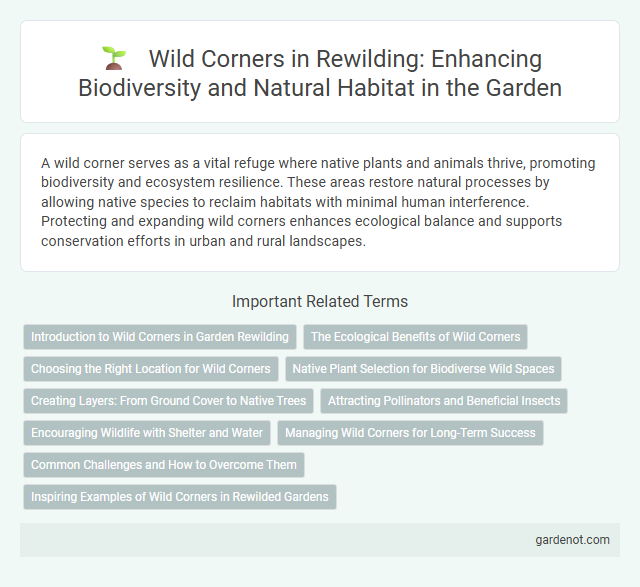A wild corner serves as a vital refuge where native plants and animals thrive, promoting biodiversity and ecosystem resilience. These areas restore natural processes by allowing native species to reclaim habitats with minimal human interference. Protecting and expanding wild corners enhances ecological balance and supports conservation efforts in urban and rural landscapes.
Introduction to Wild Corners in Garden Rewilding
Wild corners in garden rewilding create natural habitats by allowing specific areas to grow untamed, fostering biodiversity and supporting native wildlife such as pollinators, birds, and small mammals. These zones reduce garden maintenance while enhancing ecological balance through native plant species that improve soil health and water retention. Integrating wild corners promotes sustainable ecosystems and reconnects urban spaces with natural processes essential for environmental resilience.
The Ecological Benefits of Wild Corners
Wild corners significantly enhance urban biodiversity by providing essential habitats for pollinators, birds, and small mammals, contributing to ecosystem resilience and stability. These areas support natural pest control and improve soil health through organic matter accumulation and increased microbial activity. Integrating wild corners in city landscapes promotes carbon sequestration and aids in mitigating urban heat island effects, fostering overall environmental sustainability.
Choosing the Right Location for Wild Corners
Selecting the right location for wild corners involves prioritizing areas with native vegetation and existing wildlife corridors to enhance biodiversity. Proximity to water sources and minimal human disturbance ensures natural habitats thrive, supporting species migration and reproduction. Soil quality and sunlight exposure also play crucial roles in establishing resilient, self-sustaining wild corners that optimize ecological benefits.
Native Plant Selection for Biodiverse Wild Spaces
Wild Corner emphasizes native plant selection to create biodiverse wild spaces that support local ecosystems and wildlife. Choosing indigenous species enhances soil health, attracts pollinators, and fosters a resilient habitat adapted to regional climate and conditions. This approach promotes ecological balance and sustains native flora and fauna populations naturally.
Creating Layers: From Ground Cover to Native Trees
Creating layers in a wild corner enhances biodiversity by incorporating diverse plant strata, from low-lying ground cover and native grasses to shrubs and towering native trees. These multiple vegetation layers provide essential habitats for insects, birds, and small mammals, fostering ecological balance and promoting soil health. Employing native species ensures resilience and supports local wildlife, enabling a thriving natural ecosystem within the rewilding project.
Attracting Pollinators and Beneficial Insects
Wild corners create diverse habitats by planting native wildflowers, which attract pollinators such as bees, butterflies, and hoverflies. These areas support beneficial insects like ladybugs and predatory beetles, enhancing natural pest control and promoting plant health. Incorporating wild corners into gardens boosts biodiversity and strengthens local ecosystems.
Encouraging Wildlife with Shelter and Water
Creating wild corners with natural shelters such as log piles, dense shrubs, and rock formations provides essential habitats for insects, birds, and small mammals, promoting biodiversity. Integrating water sources like birdbaths, ponds, or shallow basins attracts amphibians and pollinators while supporting local ecosystems. These wildlife-friendly features enhance urban and garden environments by offering refuge and hydration, contributing to species survival and ecological balance.
Managing Wild Corners for Long-Term Success
Managing wild corners involves selecting native plant species that support local biodiversity and creating habitats for pollinators, birds, and small mammals. Regular monitoring and adaptive maintenance, such as seasonal pruning and invasive species control, ensure ecological balance and sustainability. Incorporating soil health practices and minimizing chemical inputs further enhance the resilience and long-term success of wild corner ecosystems.
Common Challenges and How to Overcome Them
Wild corners often face challenges such as invasive species domination, limited biodiversity, and human encroachment. Effective strategies include planting native species, creating buffer zones to minimize disturbance, and promoting community engagement for regular monitoring and conservation efforts. Implementing adaptive management practices ensures these wild areas thrive despite environmental pressures.
Inspiring Examples of Wild Corners in Rewilded Gardens
Wild corners in rewilded gardens serve as vital refuges for native wildlife, showcasing naturalistic planting that promotes biodiversity and ecological resilience. Examples include densely planted native grasses, pollinator-friendly wildflowers, and microhabitats like log piles or ponds, which attract birds, insects, and amphibians. These wild corners demonstrate how intentional naturalization supports ecosystem functions, enhances habitat connectivity, and fosters environmental stewardship in urban and suburban spaces.
Wild corner Infographic

 gardenot.com
gardenot.com